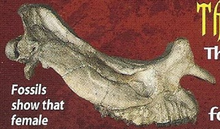Weighing in at nearly 10 thousand pounds and armed with forked horns, brontotherium dominated its territory in what is now North America. The only creature gutsy enough to challenge this beast would have been another brontotherium. Males locked horns in furious battles. When not fighting, this relative to rhinos quietly munched on plants. Climate changes may have killed its food supply, and the species eventually died out.
At the Y: Brontotherium looked much like an oversized rhino, except its horns were made of solid bone and grew from its snout in a "Y" shape. In battles over food and territory, males rammed their horns into a rival's side, often shattering their ribs.
Gum It: This beast didn't have any front teeth, but its lips were rubbery and were able to grip leaves firmly enough to tear them from branches. A few teeth in the back of brontotherium's mouth ground the soft foliage into pulp.
Thunder Beast[]

Fossils show that female "thunder beasts" had a smaller horn than males.
The earliest known people to find brontotherium fossils were the Sioux Indians of the Midwest. The fossils were close to the surface, and poked up out of the soil after heavy rains. The Sioux thought that the bones were those of a giant beast that fell from the sky during violent storms, sending thunder rolling across the land as it crashed to the ground. They named this creature the "thunder beast." In the 1870s, naturalist Othniel Charles Marsh studied the fossils. He thought the name fit, and named it brontotherium, which means "thunder beast" in Greek.
Up to its Ashes: When this beast roamed the west, the Rocky Mountains were still forming, and the region was a hotbed of volcanic activity. Scientists have found fossils of entire brontotherium herds buried in ancient volcanic ash.
Tough Break: The Earth's climate cooled about 30 million years ago, turning lush forests into open valleys filled with tough, grainy grasses. Brontotherium's teeth were too soft to chew the new foliage, so the beast died out from starvation.
Battling Bronto[]
- It's mating season, and two males are attracted to the same female. The only way to settle this is to battle it out-the males step back, then charge at each other and collide with locked horns. Heavy bone and muscle in the skull and neck prevent serious injury.
- The bigger of the two males is able to push his rival to the side after a head-on collision. Seeing an opportunity to finish the fight, the bigger brontotherium lunges at his rival's flank, cracking a few of his ribs. The injured beast limps away in defeat.
